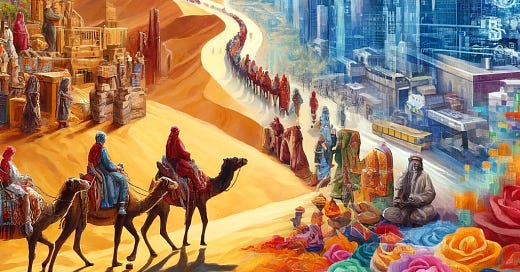The Empire of Information: From the Silk Route to Silicon Valley, a Legacy of Control
From the East India Company to the age of AI, has the quest for control through information merely changed costumes?
Blurb
A father and son conversational journey through history, uncovering the enduring legacy of the British Empire's mastery of information control, and how its echoes resonate in the digital empires of Silicon Valley.
The Ghosts of Empire in a Glass of Ginger Beer
Picture a father and son, sipping ginger beer on a warm Texas evening, discussing the intricate complexities of governance. The son, captivated by the rise of China and its centralized model, wonders if the West's faith in democracy might be faltering in the face of such a formidable competitor. He seeks his father's wisdom, hoping to glean insights from the annals of history.
The father, a scholar steeped in the legacy of the British Empire, begins with a surprising anecdote. He recounts a tale of ghost workers—fictitious employees on government payrolls, their salaries siphoned off by corrupt officials—a practice rampant in post-colonial Africa. The story serves as a stark reminder: systems of governance, even those built on noble ideals, can be corrupted and manipulated for personal gain.
The East India Company: A Blueprint for Information Dominance
The conversation shifts to the East India Company, a seemingly humble trading enterprise that transformed into a behemoth, wielding political and economic power across vast swathes of India. The father reveals how the company's success rested not just on military might, but on its mastery of information:
Mapping the Terrain: The company meticulously surveyed and documented the Indian subcontinent, creating detailed maps, compiling census data, and studying local customs and languages.
Predictive Policing: They employed a sophisticated system of intelligence gathering and surveillance, identifying potential threats and preempting rebellions before they could ignite.
Taxonomy and Social Engineering: They categorized and classified Indian society, creating rigid hierarchies and exploiting existing social divisions to maintain control.
The Sun Never Sets on the Information Empire
The father traces the evolution of this information-centric approach through the rise of the British Empire, highlighting how it became a defining feature of their global dominance:
The "Jat" Legacy: He delves into the fascinating example of the "Jat" community in India, a group categorized by the British as a "martial race." This classification, based on perceived physical and behavioral traits, had a profound impact, shaping their social roles and influencing their participation in the British Indian Army. The legacy of this classification continues to resonate today, unifying the northern part of India and serving as a reminder of the enduring power of information to shape identities and influence destinies.
Controlling the Narrative: The Empire controlled the flow of information through a network of newspapers, telegraph lines, and educational institutions, shaping public opinion and reinforcing their legitimacy.
Divide and Conquer: They refined the art of using information to sow discord among rival factions, pitting groups against each other to weaken resistance and maintain control.
Echoes in the Silicon Valley
The father draws a chilling parallel between the British Empire's methods and the emerging digital empires of Silicon Valley. He questions whether the pursuit of user data, the algorithms that shape our online experiences, and the influence of social media platforms are merely modern manifestations of an age-old quest for control:
Data as the New Currency: Tech giants amass vast troves of user data, meticulously analyzing our behaviors, preferences, and relationships.
Predictive Algorithms: Algorithms predict our desires, shape our choices, and influence our perceptions of the world, subtly steering our actions and beliefs.
Social Engineering 2.0: Social media platforms exploit our psychological vulnerabilities, amplifying divisions and shaping public discourse, often serving as echo chambers for confirmation bias and reinforcing existing power structures.
The Eternal Struggle for Control
The conversation ends on a sobering note, recognizing the enduring human desire to exert control through information. It poses a fundamental question: can we escape this cycle, or are we merely exchanging one form of control for another?
The father, while acknowledging the potential benefits of technology, urges caution and vigilance:
Awareness is Power: We must be aware of how information is used to shape our perceptions and influence our behavior.
Critical Thinking is Essential: We must question the narratives presented to us by those who control the flow of information.
Collective Action is Crucial: We must collectively resist attempts to manipulate us through information and advocate for a future where technology empowers, not controls, humanity.
The father and son’s journey through history is a stark reminder that the quest for control through information is not a relic of the past. It is a dynamic force, constantly evolving and adapting to new technologies and societal structures. The responsibility lies with us, as informed citizens, to ensure that the empires of information, both past and present, ultimately serve the common good, not the interests of a select few.
If you believe this article would interest someone you know, please feel free to share it anonymously (for us), using any medium you prefer. Thank you for considering it!





